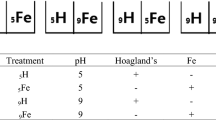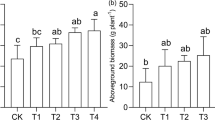Abstract
Limey soil/high soil pH is a common stressor for cucumbers which limits growth and development. Limey soil reduces iron (Fe) availability and leads to Fe chlorosis. Thus, the acquisition of Fe by plants is limited under lime-stress conditions. Plants which release organic acids can acquire Fe by adjusting the soil pH. Thus, exogenous organic acid treatment may alleviate limey soil stress. Furthermore, treatment with antioxidants may alleviate stress factors. In the present experiment, the effects of ascorbic (AsA) and oxalic acids (OA) on cucumber seedlings under lime-stress conditions were evaluated. Cucumber seedlings were grown under mildly limey soil conditions (pH = 8, CaCO3 = 10%). The treatments Fe-EDDHA, 50 and 100 ppm ASA, and 3 and 10 mmol OA were applied at sowing and repeated weekly. Control plants did not receive Fe-EDDHA, AsA, and OA application. Seedlings were evaluated 30 days after sowing. AsA and OA treatments significantly affected cucumber seedlings. We evaluated the Dickson quality index parameter to compare seedling quality among the treatments, and results showed that Fe-EDDHA-treated seedlings had the highest value followed by 100 ppm AsA and 3 mmol OA. AsA and OA treatments increased the xylem conduit diameter compared to control and Fe-EDDHA treatments. The 3 mmol OA and 100 mmol AsA treatments triggered lignification. The highest cortical cell diameter was found in 100 ppm AsA followed by 3 mmol OA treatments. As a result, we suggest that AsA and OA can be used under high soil pH conditions.



Similar content being viewed by others
References
Abadía J, Vázquez S, Rellán-Álvarez R, El-Jendoubi H, Abadía A, Álvarez-Fernández A, López-Millán AF (2011) Towards a knowledge-based correction of iron chlorosis. Plant Physiol Biochem 49(5):471–482
Ahammed GJ, Wu M, Wang Y, Yan Y, Mao Q, Ren J, Ma R, Liu A, Chen S (2020) Melatonin alleviates iron stress by improving iron homeostasis, antioxidant defense and secondary metabolism in cucumber. Sci Hortic 265:109205
Antonova GF, Chaplygina IA, Varaksina TN, Stasova VV (2005) Ascorbic acid and xylem development in trunks of the Siberian larch trees. Russ J Plant Physiol 52(1):83–92
Aras S, Keles H (2019) Responses of apple plants to drought stress. J Agric Stud 7(3):154–160
Aras S, Arıkan Ş, İpek M, Eşitken A, Pırlak L, Dönmez MF, Turan M (2018) Plant growth promoting rhizobacteria enhanced leaf organic acids, FC‑R activity and Fe nutrition of apple under lime soil conditions. Acta Physiol Plant 40(6):120
Aras S, Keles H, Bozkurt E (2021) Physiological and histological responses of peach plants grafted onto different rootstocks under calcium deficiency conditions. Sci Hortic 281:109967
Aras S, Keles H, Bozkurt E (2022) Iron deficiency impacts chlorophyll biosynthesis, leaf cell expansion, xylem development and physiology of Prunus persica grafted onto rootstocks Garnem and GF 677. Zemdirbyste-Agriculture 109(1):55–62
Arıkan Ş, Eşitken A, İpek M, Aras S, Şahin M, Pırlak L, Dönmez MF, Turan M (2018) Effect of plant growth promoting rhizobacteria on Fe acquisition in peach (Prunus persica L) under calcareous soil conditions. J Plant Nutr 41(17):2141–2150
Awad AA, Sweed AA, Rady MM, Majrashi A, Ali EF (2021) Rebalance the nutritional status and the productivity of high CaCO3-stressed sweet potato plants by foliar nourishment with zinc oxide nanoparticles and ascorbic acid. Agronomy 11(7):1443
Bityutskii NP, Yakkonen KL, Petrova AI, Lukina KA, Shavarda AL (2019) Calcium carbonate reduces the effectiveness of soil-added monosilicic acid in cucumber plants. J Soil Sci Plant Nutr 19(3):660–670
Bortolami G, Farolfi E, Badel E, Burlett R, Cochard H, Ferrer N, King A, Lamarque LJ, Lecomte P, Marchesseau-Marchal M, Pouzoulet J, Torres-Ruiz JM, Trueba S, Delzon S, Gambetta GA, Delmas CEL (2021) Seasonal and long-term consequences of esca grapevine disease on stem xylem integrity. J Exp Bot 72(10):3914–3928
Dong Y, Chen W, Zhuge Y, Song Y, Hu G, Wan Y, Liu F, Li X (2018) Effect of application of exogenous nitric oxide at different critical growth stages in alleviating Fe deficiency chlorosis of peanut growing in calcareous soil. J Plant Nutr 41(7):867–887
Donnini S, Castagna A, Ranieri A, Zocchi G (2009) Differential responses in pearand quince genotypes induced by Fe deficiency and bicarbonate. J Plant Physiol 166:1181–1193
Duan C, Wu S, Sang Y, Bahetibieke W, Ru J, Song J, Cui X (2019) Exogenous succinic acid mediates responses of Larix olgensis A. Henry to cadmium stress. Int J Phytoremediation 21(8):742–751
Fahad S, Bajwa AA, Nazir U, Anjum SA, Farooq A, Zohaib A, Sadia S, Nasim W, Adkins S, Saud S, Ihsan MZ, Alharby H, Wu C, Wang D, Huang J (2017) Crop production under drought and heat stress: plant responses and management options. Front Plant Sci 8:1147
Ghahremani Z, Mikaealzadeh M, Barzegar T, Ranjbar ME (2021) Foliar application of ascorbic acid and gamma aminobutyric acid can improve important properties of deficit irrigated cucumber plants (Cucumis sativus cv. Us). Gesunde Pflanzen 73(1):77–84
Hernández-Apaolaza L, Escribano L, Zamarreño ÁM, García-Mina JM, Cano C, Carrasco-Gil S (2020) Root silicon addition induces Fe deficiency in cucumber plants, but facilitates their recovery after Fe resupply. A comparison with si foliar sprays. Front Plant Sci 11:580552
Hoagland DR, Arnon DI (1950) The water-culture method for growing plants without soil. Circular, vol 347. Agricultural Experiment Station, University of California, Berkeley
Imran, Amanullah, Ortas I (2022) Agronomic practices improved cucumber productivity, nutrients uptake and quality. Gesunde Pflanzen 74:595–602. https://doi.org/10.1007/s10343-022-00634-1
İpek M, Aras S, Arıkan Ş, Eşitken A, Pırlak L, Dönmez MF, Turan M (2017) Root plant growth promoting rhizobacteria inoculations increase ferric chelate reductase (FC-R) activity and Fe nutrition in pear under calcareous soil conditions. Sci Hortic 219:144–151
Jafari SR, Arvin SMJ, Kalantari KM (2015) Response of cucumber (Cucumis sativus L.) seedlings to exogenous silicon and salicylic acid under osmotic stress. Acta Biol Szeged 59(1):25–33
Jensen WA (1962) Botanical histochemistry: principles and practice. W.H. Freeman & Co, San Francisco
Kaya C, Akram NA, Ashraf M (2019) Influence of exogenously applied nitric oxide on strawberry (Fragaria × ananassa) plants grown under iron deficiency and/or saline stress. Physiol Plant 165(2):247–263
Li P, Zheng X, Liu Y, Zhu Y (2014) Pre-storage application of oxalic acid alleviates chilling injury in mango fruit by modulating proline metabolism and energy status under chilling stress. Food Chem 142:72–78
Li P, Yin F, Song L, Zheng X (2016) Alleviation of chilling injury in tomato fruit by exogenous application of oxalic acid. Food Chem 202:125–132
Li Q, Jiang N, Mei X, Zu Y, Li Z, Qin L, Li B (2022) Effects of lime and oxalic acid on antioxidant enzymes and active components of Panax notoginseng under cadmium stress. Sci Rep 12(1):1–13
Lutts S, Kinet JM, Bouharmont J (1996) NaCl-induced senescence in leaves of rice (Oryza sativa L.) cultivars differing in salinity resistance. Ann Bot 78:389–398
Maksoud MA, Saleh MA, El-Shamma MS, Fouad AA (2009) The beneficial effect of biofertilizers and antioxidants on olive trees under calcareous soil conditions. World J Agric Sci 5(3):350–352
Malenčić DJ, Vasić D, Popović M, Dević D (2004) Antioxidant systems in sunflower as affected by oxalic acid. Biol plant 48(2):243–247
Malta PG, Arcanjo-Silva S, Ribeiro C, Campos NV, Azevedo AA (2016) Rudgea viburnoides (Rubiaceae) overcomes the low soil fertility of the Brazilian Cerrado and hyperaccumulates aluminum in cell walls and chloroplasts. Plant Soil 408(1):369–384
Merwad ARM, Abdel-Fattah MK (2015) Effect of some soil amendments and foliar spray of salicylic and ascorbic acids on sorghum under saline calcareous soil conditions. Int J Soil Sci 10(1):28
Mondal K, Sharma NS, Malhotra SP, Dhawan K, Singh R (2004) Antioxidant systems in ripening tomato fruits. Biol plant 48(1):49–53
Morales F, Abadía A, Abadía J (1990) Characterization of the xanthophyll cycle and other photosynthetic pigment changes induced by iron deficiency in sugar beet (Beta vulgaris L.). Plant Physiol 94(2):607–613
Naz H, Akram NA, Ashraf M (2016) Impact of ascorbic acid on growth and some physiological attributes of cucumber (Cucumis sativus) plants under water-deficit conditions. Pak J Bot 48(3):877–883
O’Brien T, Feder N, McCully ME (1964) Polychromatic staining of plant cell walls by toluidine blue O. Protoplasma 59(2):368–373
Pii Y, Penn A, Terzano R, Crecchio C, Mimmo T, Cesco S (2015) Plant-microorganism-soil interactions influence the Fe availability in the rhizosphere of cucumber plants. Plant Physiol Biochem 87:45–52
Ramírez L, Bartoli CG, Lamattina L (2013) Glutathione and ascorbic acid protect Arabidopsis plants against detrimental effects of iron deficiency. J Exp Bot 64(11):3169–3178
Richards LA (1954) Diagnosis and improvement of saline and alkali soils. USDA agric. handbook, vol 60. USDA, Washington D. C.
Sadak MS, Orabi SA (2015) Improving thermo tolerance of wheat plant by foliar application of citric acid or oxalic acid. Int J Chem Tech Res 8:333–345
Shah T, Latif S, Khan H, Munsif F, Nie L (2019) Ascorbic acid priming enhances seed germination and seedling growth of winter wheat under low temperature due to late sowing in Pakistan. Agronomy 9(11):757
Shi DC, Yin SJ, Yang GH, Zhao K (2002) Citric acid accumulation in an alkali—tolerant plant Puccinellia tenuiflora under alkaline stress. Acta Bot Sin 44:537–540
Shu-Hua G, Yan-Jie N, Heng Z, Ning H, Yuan-Peng D (2018) Effects of alkaline stress on organic acid metabolism in roots of grape hybrid rootstocks. Sci Hortic 227:255–260
Smart RE, Bingham GE (1974) Rapid estimates of relative water content. J Plant Physiol 53:258–260
Smirnoff N, Wheeler GL (2000) Ascorbic acid in plants: biosynthesis and function. CRC Crit Rev Plant Sci 19(4):267–290
Sperdouli I, Moustakas M (2012) Interaction of proline, sugars, and anthocyanins during photosynthetic acclimation of Arabidopsis thaliana to drought stress. J Plant Physiol 169(6):577–585
Sun G, Feng C, Zhang A, Zhang Y, Chang D, Wang Y, Ma Q (2019) The dual role of oxalic acid on the resistance of tomato against Botrytis cinerea. World J Microbiol Biotechnol 35(2):1–7
Torres-Ruiz JM, Cochard H, Fonseca E, Badel E, Gazarini L, Vaz M (2017) Differences in functional and xylem anatomical features allow Cistus species to co-occur and cope differently with drought in the Mediterranean region. Tree Physiol 37(6):755–766
Toselli M, Marangoni B, Tagliavini M (2000) Iron content in vegetative and reproductive organs of nectarine trees in calcareous soils during the development of chlorosis. Eur J Agron 13:279–286
Weng JK, Chapple C (2010) The origin and evolution of lignin biosynthesis. New Phytol 187(2):273–285
Whetten RW, MacKay JJ, Sederoff RR (1998) Recent advances in understanding lignin biosynthesis. Annu Rev Plant Biol 49(1):585–609
Zhang X, Yu HJ, Zhang XM, Yang XY, Zhao WC, Li Q, Jiang WJ (2016) Effect of nitrogen deficiency on ascorbic acid biosynthesis and recycling pathway in cucumber seedlings. Plant Physiol Biochem 108:222–230
Zhang XW, Dong YJ, Qiu XK, Hu GQ, Wang YH, Wang QH (2012) Exogenous nitric oxide alleviates iron-deficiency chlorosis in peanut growing on calcareous soil. Plant Soil Environ 58(3):111–120
Zheng X, Tian S (2006) Effect of oxalic acid on control of postharvest browning of litchi fruit. Food Chem 96(4):519–523
Zheng J, Li S, Xu Y, Zheng X (2019) Effect of oxalic acid on edible quality of bamboo shoots (Phyllostachys prominens) without sheaths during cold storage. Lwt 109:194–200
Zheng X, Tian S, Meng X, Li B (2007) Physiological and biochemical responses in peach fruit to oxalic acid treatment during storage at room temperature. Food Chem 104(1):156–162
Zhixin N, Xiaodong L, Lina S, Tieheng S (2013) Dynamics of three organic acids (malic, acetic and succinic acid) in sunflower exposed to cadmium and lead. Int J Phytoremediation 15(7):690–702
Author information
Authors and Affiliations
Corresponding author
Ethics declarations
Conflict of interest
G.A. Çoban and S. Aras declare that they have no competing interests.
Rights and permissions
Springer Nature or its licensor (e.g. a society or other partner) holds exclusive rights to this article under a publishing agreement with the author(s) or other rightsholder(s); author self-archiving of the accepted manuscript version of this article is solely governed by the terms of such publishing agreement and applicable law.
About this article
Cite this article
Çoban, G.A., Aras, S. Effects of Ascorbic and Oxalic Acids on Cucumber Seedling Growth and Quality Under Mildly Limey Soil Conditions. Gesunde Pflanzen 75, 1925–1932 (2023). https://doi.org/10.1007/s10343-022-00809-w
Received:
Accepted:
Published:
Issue Date:
DOI: https://doi.org/10.1007/s10343-022-00809-w




